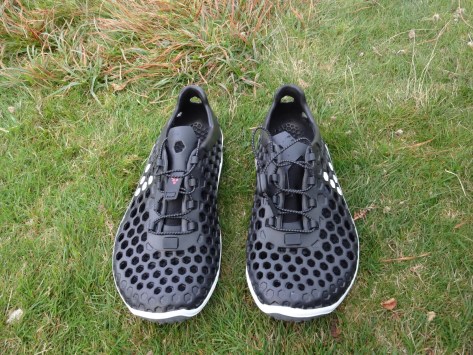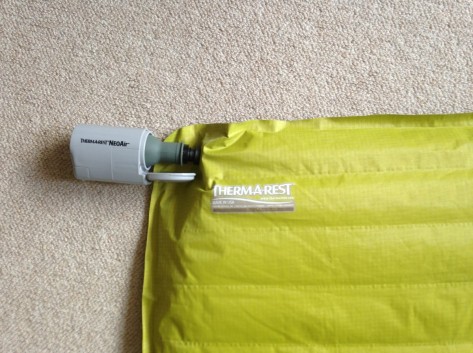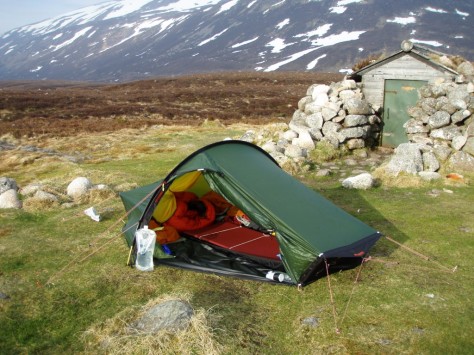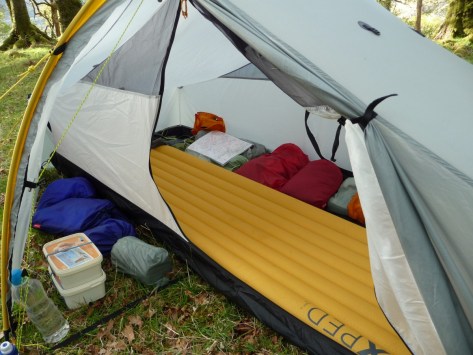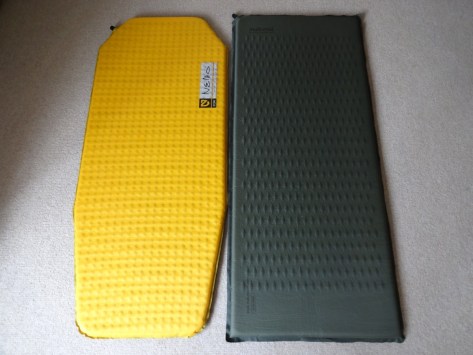Vivobarefoot Ultra Pure shoes.
These are excellent shoes for around camp. They only weigh 232g for a pair. With the exception of the tongue (which is removable), they don’t absorb water. They ought to make good river crossing shoes. The soles are quite thin, but adequate for general use. They also pack down reasonably flat. The fit is quite broad, so it’s worth getting a size smaller than normal. Until now I’ve been using Nike Mayflys, but these are lighter and better for river crossings, so I reckon the Ultra Pures are a keeper.
 Thermarest X-lite Short.
Thermarest X-lite Short.
For the Challenge I used a Neoair Short, which was good but had a tendency to deflate slightly during the night. The X-lite doesn’t share that problem and stayed inflated. It’s more comfortable though when slightly under inflated. The tapered shape saves some weight but at the expense of some comfort. I found it better to have the narrow end under my head and the wider end under my hips. Used this way it was decently comfortable and the transition under my thighs from air mat to foam mat was more comfortable than the NeoAir. Used the other way round I found my legs and hips coming off the mat (I’m a side sleeper). I was impressed by the level of insulation. One minor drawback was the bright yellow colour attracted bugs. However, I like this mat for three season use (in conjunction with a thin foam mat). Apart from. Klymit mat, this is about as light as you’ll get for an air mat at 212g.
Fozzils bowl.
This is an unusual bit of gear. It’s really a small dog bowl. It weighs 37g. It’s flat, but folds into a bowl using snap closures. I used it as a washing bowl. It’s big enough to wash your hands in. It’s very useful to be able to scoop some water out of a stream and use as a wash bowl for face and hands, instead of balancing on a rock. It also means that soapy water can be disposed of without contaminating the water supply. Although it didn’t happen on this trip, you can have a proper wash in the porch of your shelter if it’s pouring with rain outside. In the overall scheme of things, it’s not a vital bit of gear, but at 37g, it’s a trivial weight for some flexibility. You could also use it as a cutting board or food bowl if you wanted.
Clothing.
I took a number of new items with me. As there was no rain, there was no chance to test the Marmot Essence jacket or overtrousers. As a mid layer, I used the Rab Zephyr jacket. This is the jacket version of the Boreas smock. It’s only marginally heavier than the Boreas but has a full length zip and two large, mesh backed venting pockets. Just as importantly the shoulders and outside of the arms are made from a more robust and wind proof material. I found the main body material not to be that wind proof or water resistant. However the shoulder and arm material is properly wind and water resistant. This made for a good combination and it was very comfortable over a wide range of temperatures and wind conditions. Adding a Marmot Driclime vest increased the overall wind resistance and warmth. It didn’t smell either! I like the Zephyr. It’s pretty light at 278g and has a lot of flexibility over a wide range of conditions. Oh, and the hood was quite useful as well.
As base layers I used Berghaus VapourLight and Rohan Ultra T. Both were very good combos with the Zephyr. The Ultra T is terrific at getting rid of sweat quickly. The VapourLight is good as well, although a bit thicker. Both resist body odour well and dry quickly. I used a long sleeve VapouLight for sleeping and it was very comfortable. I think Berghaus are on to a bit of a winner here.
I used my As Tucas Foratata down booties for the first time. Even though it wasn’t cold, it was nice to be able to warm up my feet in the late evening. They are well made with good loft. Weighing only 61g for a Medium, they are a great bit of gear.
The final piece of new clothing was an Arc’teryx Squamish hoody. Strictly speaking, I didn’t really need it as the combination of the Rab Zephyr and Marmot Driclime vest would have sufficed. However, I bought the Squamish in a sale (virtually half price) recently and I wanted to try it. It really is a high quality wind jacket. Although it weighs only 150g, the material feels a lot more robust than competitors. It also has a nice matt finish and is pleasant against the skin. The fit is good and it has an excellent hood that cinches firmly and moves with your head. The DWR seems to be more effective than other jackets, while maintaining a good level of breathability. I didn’t test it fully, but it was good for an hour while it was drizzly and muggy. I shall be using it again.
